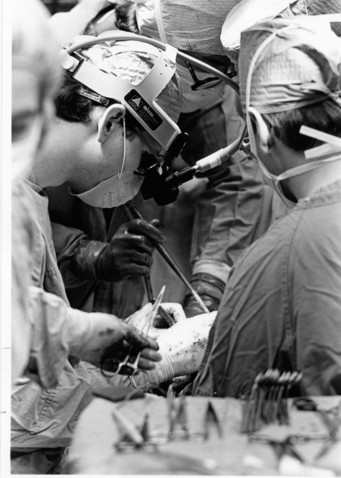By Tripp Underwood
Boston Children’s Hospital performed its first liver transplant. But if you were to compare the Liver Transplant Program back in 1984 to the bustling, multidisciplinary team of specialists it is today, you might not even recognize it—the program has grown so much!
Dawn of a new era
In the grand scheme of things, liver transplants are a relatively new procedure. It was first attempted on a few adults in the 1960s, but none of these patients lived very long. Surgical complications and repeated graft failures made the process too dangerous, so it was only attempted in the most extreme cases back then.
But through the 70s, surgeons were perfecting their techniques while researchers were developing cyclosporine, a powerful anti-rejection drug with incredible promise. By the early 80s, doctors were using cyclosporine regularly, ushering in a new age of immunosuppressive medicine that made organ transplantation a safer option for many patients.
“It changed everything,” says Maureen Jonas, MD, current medical director of Boston Children’s Liver Transplant Program.”Suddenly, a whole new door was open to us as doctors, and we had the chance to save so many more kids.”
Boston Children’s performed its first liver transplant in 1984, and the number of young patients treated by the Liver Transplant Program went up every year. But as time passed and more and more patients were treated, it became clear the program needed its own medical director with the background in hepatology to take it to the next level. Alan Leichtner, MD, MSHPE, associate chief of Boston Children’s Division of Gastroenterology, Hepatology and Nutrition, knew his medical school colleague Dr. Jonas would be perfect for the job, but she was practicing in Miami. Jonas has always hated the cold, so getting her to leave the sun of Miami was no easy task, but Leichtner was persistent, and by the early 90s, Jonas left Miami to join the Boston Children’s team as medical director of the Liver Transplant Program.
With the final piece of the puzzle in place, the program embarked on what would become a period of extreme growth.
A rapidly growing field
At Boston Children’s, Jonas partnered with transplant coordinator Laura O’Melia, CPNP, and surgical director Joseph Vacanti. (Vacanti was replaced by current surgical director Heung Bae Kim, MD in 2003.) At that point, the trio was the entire program. “It was just the three of us, but together we managed to cover everything,” Jonas remembers. “It was a small team, but a great one to be a part of.”
The small but effective group continued to care for all its patients, but as the years progressed, the field of pediatric liver transplantation advanced rapidly, increasing their caseload.
It was during this time that the rules that governed how donor organs were allocated changed: Priority was given to sicker patients regardless of how long they spent on the waiting list, leading to more transplants and more saved lives. Soon after, exciting new surgical techniques such as living donor and split-liver procedures were created and perfected, which in turn made even more donor livers available to children, especially the very young and small.
 In addition, after years of study, doctors had developed a much stronger understanding of the human immune system, which allowed them to better prescribe immunosuppression medications and coordinate follow-up care. All of these advances combined made liver transplants a far less risky procedure and a viable treatment option for children who a few years earlier may have been considered too sick for the procedure.
In addition, after years of study, doctors had developed a much stronger understanding of the human immune system, which allowed them to better prescribe immunosuppression medications and coordinate follow-up care. All of these advances combined made liver transplants a far less risky procedure and a viable treatment option for children who a few years earlier may have been considered too sick for the procedure.
“At the beginning of my career, I saw many advanced liver failure patients and knew there was nothing we could do to help them,” Jonas says. “But thanks to all the growth the field has seen in the past 30 years, that’s no longer the case. When I see these families today, I can say, ‘We have a long road ahead of us, but at the other end of that road, there will be a normal life with college and jobs and marriage.'”
As transplant medicine improved and grew, so did the team at Boston Children’s. What once was a three-person operation has developed into a program with a staff of over 20 care providers, including two pediatric transplant surgeons and four board-certified, pediatric transplant hepatologists.
But despite its new size, the team never lost its deep appreciation for the power of collaboration. Where many liver transplant programs are clearly separated in terms of what roles are played by the medical and surgical teams, the staff at Boston Children’s Liver Transplant Program are equally involved in each patient’s care, every step of the way.
